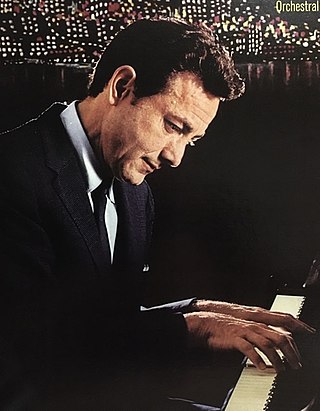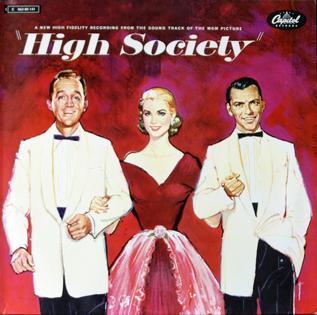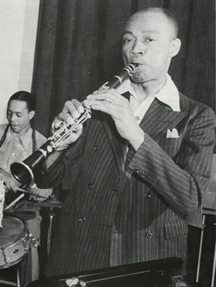Related Research Articles

Louis Daniel Armstrong, nicknamed "Satchmo", "Satch", and "Pops", was an American trumpeter and vocalist. He was among the most influential figures in jazz. His career spanned five decades and several eras in the history of jazz. He received numerous accolades including the Grammy Award for Best Male Vocal Performance for Hello, Dolly! in 1965, as well as a posthumous win for the Grammy Lifetime Achievement Award in 1972, and induction into the National Rhythm & Blues Hall of Fame in 2017.

High Society is a 1956 American musical romantic comedy film directed by Charles Walters and starring Bing Crosby, Grace Kelly, and Frank Sinatra. The film was produced by Sol C. Siegel for Metro-Goldwyn-Mayer, and shot in VistaVision and Technicolor, with music and lyrics by Cole Porter.
"Little One" is a song written by Cole Porter for the 1956 film High Society, where it was introduced by Bing Crosby.

James "Trummy" Young was an American trombonist in the swing era. He established himself as a star during his 12 years performing with Louis Armstrong in Armstrong's All Stars. He had one hit with his version of "Margie", which he played and sang with Jimmie Lunceford's orchestra in 1937. During his years with Armstrong, Young modified his playing to fit Armstrong's approach to jazz.
"They Can't Take That Away from Me" is a 1937 popular song with music by George Gershwin and lyrics by Ira Gershwin. It was introduced by Fred Astaire in the 1937 film Shall We Dance and gained huge success.

Joe Bushkin was an American jazz pianist.
The Edsel Show is an hour-long television special broadcast live on CBS in the United States on October 13, 1957, intended to promote Ford Motor Company's new Edsel cars. It was a milestone in the long career of entertainer Bing Crosby and is notable as the first CBS entertainment program to be recorded on videotape for rebroadcast in the western part of the country following a live performance for the east coast. Crosby arranged for this ‘live’ program to be ‘produced’ by his alma mater Gonzaga University in order that the profits could go to them in a tax efficient way. The program won the ‘Look’ magazine TV Award for ‘Best Musical Show’ and was nominated for an Emmy as the “Best Single Program of the Year”.

"A Fine Romance" is a popular song composed by Jerome Kern with lyrics by Dorothy Fields, published in 1936.

High Society is a 1956 soundtrack album, featuring Bing Crosby, Frank Sinatra, Louis Armstrong and Grace Kelly. This was Crosby's fifth LP album, and his first recorded for Capitol Records. It was the soundtrack for the MGM feature film High Society, also released in 1956. Initially issued on vinyl either in mono or stereo format, the album has been issued on CD by Capitol in Japan in 1991 and by Capitol in the UK in 1995. The album was also included in a 3-CD box set called "Original Soundtrack Recordings" issued by the EMI Music Group Australasia

Edmond Hall was an American jazz clarinetist and bandleader. Over his career, Hall worked extensively with many leading performers as both a sideman and bandleader and is possibly best known for the 1941 chamber jazz song "Profoundly Blue".

Barrett Deems was an American swing drummer from Springfield, Illinois, United States. He worked in bands led by Jimmy Dorsey, Louis Armstrong, Red Norvo, and Muggsy Spanier.
"I Love You, Samantha" is a song written by Cole Porter for the 1956 film High Society, where it was introduced by Bing Crosby.
"It's All Right with Me" is a popular song written by Cole Porter, for his 1953 musical Can-Can, where it was introduced by Peter Cookson as the character Judge Aristide Forestier.

"I Don't Stand a Ghost of a Chance With You" is a 1932 song recorded by Bing Crosby with Orchestral Accompaniment. The music was composed by Victor Young, with lyrics written by Ned Washington and Bing Crosby. The song is a jazz and pop standard recorded by many different artists.

Swing jazz emerged as a dominant form in American music, in which some virtuoso soloists became as famous as the band leaders. Key figures in developing the "big" jazz band included bandleaders and arrangers Count Basie, Cab Calloway, Jimmy and Tommy Dorsey, Duke Ellington, Benny Goodman, Fletcher Henderson, Earl Hines, Glenn Miller, and Artie Shaw. Duke Ellington and his band members composed numerous swing era hits that have become standards: "It Don't Mean a Thing " (1932), "Sophisticated Lady" (1933) and "Caravan" (1936), among others. Other influential bandleaders of this period were Benny Goodman and Count Basie.

The period from the end of the First World War until the start of the Depression in 1929 is known as the "Jazz Age". Jazz had become popular music in America, although older generations considered the music immoral and threatening to cultural values. Dances such as the Charleston and the Black Bottom were very popular during the period, and jazz bands typically consisted of seven to twelve musicians. Important orchestras in New York were led by Fletcher Henderson, Paul Whiteman and Duke Ellington. Many New Orleans jazzmen had moved to Chicago during the late 1910s in search of employment; among others, the New Orleans Rhythm Kings, King Oliver's Creole Jazz Band and Jelly Roll Morton recorded in the city. However, Chicago's importance as a center of jazz music started to diminish toward the end of the 1920s in favor of New York.
High Society Calypso is a song written by Cole Porter for the 1956 American movie High Society. It was performed by Louis Armstrong and his band of Edmond Hall on the clarinet, Trummy Young on the trombone, Billy Kyle on the piano, Arvell Shaw playing the bass and Barrett Deems as the drummer.

The collaborations between Ella Fitzgerald and Louis Armstrong have attracted much attention over the years. The artists were both widely known icons not just in the areas of big band, jazz, and swing music but across 20th century popular music in general. The two African-American musicians produced three official releases together in Ella and Louis (1956), Ella and Louis Again (1957), and Porgy and Bess (1959). Each release earned both commercial and critical success. As well, tracks related to those albums have also appeared in various forms in multi-artist collections and other such records.
References
- ↑ Schwartz, Charles (1979). Cole Porter: A Biography . New York: Da Capo Press. p. 300. ISBN 0306800977.
- ↑ "A Bing Crosby Discography". BING magazine. International Club Crosby. Retrieved September 12, 2016.
- ↑ Reynolds, Fred (1986). The Crosby Collection 1926–1977 (Part Four: 1951–1960 ed.). Gateshead, UK: John Joyce. pp. 158–159.